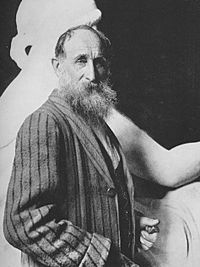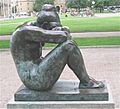Aristide Maillol facts for kids
Quick facts for kids
Aristide Maillol
|
|
|---|---|

Aristide Maillol (1925), in a photograph by Alfred Kuhn
|
|
| Born |
Aristide Joseph Bonaventure Maillol
December 8, 1861 Banyuls-sur-Mer, Roussillon
|
| Died | September 27, 1944 (aged 82) Banyuls-sur-Mer, Roussillon
|
| Nationality | French |
| Education | École des Beaux-Arts |
| Known for | Sculpture, painting |
Aristide Joseph Bonaventure Maillol (December 8, 1861 – September 27, 1944) was a famous French sculptor. He was also a talented painter and printmaker.
Contents
About Aristide Maillol
Early Life and Art Studies
Aristide Maillol was born in a town called Banyuls-sur-Mer, in a region of France called Roussillon. From a young age, he knew he wanted to be a painter. In 1881, he moved to Paris to study art.
It took him a few years, and he lived in poverty for a while. But in 1885, he was finally accepted into the École des Beaux-Arts, a famous art school. There, he learned from well-known artists like Jean-Léon Gérôme and Alexandre Cabanel. His early paintings showed the style of other artists of his time, like Pierre Puvis de Chavannes and Paul Gauguin.
From Tapestry to Sculpture
Paul Gauguin helped Maillol become more interested in decorative art. This is art that is meant to be beautiful and useful, like patterns or designs. This interest led Maillol to start designing tapestries. Tapestries are thick woven cloths with pictures or designs, often used as wall hangings.
In 1893, Maillol opened his own tapestry workshop in Banyuls. His tapestries were very well made and beautiful. They helped him become known for bringing this art form back to life in France.
Around 1895, Maillol started making small sculptures out of terracotta, which is a type of clay. Within a few years, he loved sculpture so much that he stopped making tapestries.
Family Life
In July 1896, Maillol married Clotilde Narcis. She used to work for him at his tapestry workshop. Their only son, Lucian, was born in October of that year.
Famous Sculptures
Maillol's first big sculpture was called A Seated Woman. He used his wife as the model for this piece. The first version was finished in 1902 and was later renamed La Méditerranée (The Mediterranean).
Maillol believed that "art does not lie in the copying of nature." This means he thought art was more than just making something look exactly like real life. So, in 1905, he made a second version of A Seated Woman that looked less realistic. In 1902, an art dealer named Ambroise Vollard helped Maillol have his first art show.
Almost all of Maillol's later work focused on the female body. He sculpted them in a classical style, which means they looked strong, calm, and balanced. His large bronze sculptures are seen as an important step before the simpler styles of artists like Henry Moore. His calm, classical style was very important for figure sculpture in Europe until the end of World War II.
A writer named Josep Pla once said about Maillol's work that it brought old Greek ideas into modern sculpture. He meant that Maillol's art felt new and fresh, just like the best art from ancient times.
Public Art and Illustrations
Maillol also created many public sculptures. For example, he was asked to make a monument for the artist Paul Cézanne in 1912. He also made many memorials after World War I to remember those who had died.
He also created woodcut illustrations for books. These included an edition of Virgil's Eclogues (published in 1926–27), Daphnis and Chloe by Longus (1937), and Chansons pour elle by Paul Verlaine (1939).
Later Life and Legacy
Aristide Maillol died in Banyuls when he was 83 years old. He was in a car accident during a thunderstorm. The car he was riding in skidded off the road and rolled over.
Today, you can see a large collection of Maillol's artwork at the Musée Maillol in Paris. This museum was started by Dina Vierny, who was Maillol's model and friend for the last 10 years of his life. His home, a few kilometers outside Banyuls, is also a museum called the Musée Maillol Banyuls-sur-Mer. It shows many of his works and sketches.
Three of his bronze sculptures are on the grand staircase of the Metropolitan Opera House in New York City. These include Summer (1910–11), Venus Without Arms (1920), and Kneeling Woman: Monument to Debussy (1950–55). The third one is a copy of a sculpture he made for the French city of Saint-Germain-en-Laye, which was the birthplace of the composer Claude Debussy.
Art During World War II
During the German occupation of France in World War II, some of Maillol's artworks were taken by a German group. These artworks were later found. For example, a sculpture called "Head of Flora" was found with other art collected by Cornelius Gurlitt.
After the war, a group called the Monuments, Fine Arts, and Archives program helped to find and return many artworks. A photograph from 1946 shows members of this group getting one of Maillol's sculptures, Baigneuse à la draperie, ready to be sent back to France. Many artworks by Maillol that had been taken were eventually returned to their owners.
Works
- Action in Chains (1905)
- L'Été sans bras (1911)
- Bathing Woman with Raised Arms (1921)
- Nymph (1930)
- The Mountain (1937)
- L'Air (1938)
- The River (1938–43)
- Mme Henry Clemens van de Velde (c. 1899)
Images for kids
-
Aristide Maillol, The Night, (1920), Stuttgart
See also
 In Spanish: Aristide Maillol para niños
In Spanish: Aristide Maillol para niños


